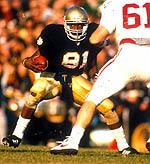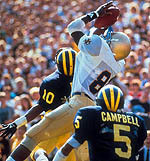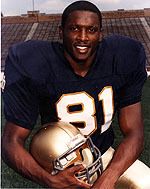Nov. 17, 2006
Victorious Amid Defeat
From humble football roots, Tim Brown became one of the greatest players ever in college and pro football
By Lou Somogyi
Seldom in nearly 25 years of football was Tim Brown part of a winning organization.
Yet in an ironic twist of fate, that’s how he became such a winner on and off the field.
It goes back to his days as a varsity member of Woodrow Wilson High in Dallas, Texas from 1981-83. During Brown’s career, Wilson was 4-25-1, winning one game in his sophomore campaign, two as a junior and one as a senior.
“The lack of success by our high school team helped me in a way because it made me play harder than ever each week,” said Brown during his student days at Notre Dame. “I figured that if I wanted to get a college scholarship I would have to make each play count and take nothing for granted.
“Every time I touched the ball I said to myself I’d better do something good with it or I’d never make it anywhere.”
Although overlooked by many high school blue-chip publications, the diamond in the rough received enough notice to take official visits as a senior to Notre Dame, Iowa, SMU, Oklahoma and Nebraska, and the decision came down to SMU – located only two miles from his home – or Gerry Faust’s Irish. Confronted with immense pressure to stay in state with a program that was handed the NCAA death penalty in the late 1980s, Brown, with some inspiration from his family, opted for the Fighting Irish.
Four years later after accepting the Heisman Trophy as the nation’s premier college player, Brown was asked whether Notre Dame’s name was what helped him receive the award.
“I’m not going to apologize for going to Notre Dame,” Brown replied. “I did it to better myself as a person.”
That mission was fulfilled – and then some – as an athlete, a current entrepreneur, NFL analyst, husband and father.
In 1995, Brown became the National Chairman of Athletes & Entertainers for Kids and 911 for Kids, and his service to others has earned him just as much respect as his nine Pro Bowl appearances with the Los Angeles/Oakland Raiders.
“I was fortunate to grow up in a wonderful, supportive and loving family,” Brown said. “I realized early on that many children are not as fortunate and just finding a meal is a daily fight for thousands of youth.” Often characterized as the “anti-Raider” for his clean-cut background, Brown still was confident and brash enough to clash with mercurial Raiders owner Al Davis, or even tell a deeply religious teammate that it was fine to read the Bible – but he better start reading the playbook, too. As a Notre Dame freshman, Brown was the first player to handle the ball to open the 1984 campaign against Purdue, and it resulted in a fumbled kickoff return that the Boilermakers recovered and turned into a score in their 23-21 upset victory.
How’s that for a grand entry?
Several weeks later, the Irish lost their third straight at home (for the first time since 1956) and were booed as they walked off their home turf with a 3-4 record.
“Most guys here came from state champion teams and were always used to winning. They were really down, but I’d think, `Oh man, what’s wrong? We’ve already won three games,’ ” said Brown laughing.
In Brown’s four seasons, the Irish were only 25-21, including 0-2 in two bowl appearances. He was part of the lone back-to-back losing seasons at the school in 1985 with Faust (5-6) and 1986 with Lou Holtz (5-6). When Holtz arrived, the new Irish head coach vowed “the only way we’re going to keep the ball out of Tim Brown’s hands is if they intercept the snap from center.”
Utilizing Brown in the backfield, at wideout and as both a kick and punt returner, Holtz maximized Brown’s skills and saw him produce, to this day, the two most all-purpose yards gained in a season at Notre Dame – first with 1,937 (1986) and then 1,847 (1987).
Brown made Fighting Irish football hip again, and his brilliance in 1986-87 helped attract premier recruits such as Raghib “Rocket” Ismail, Ricky Watters, Todd Lyght, Chris Zorich, and a plethora of others, into the fold during Holtz’s halcyon years from 1988-93, when the Irish were 64-9-1 with one national title and two debatable No. 2 finishes.
Brown’s senior year did see the Irish produce their best record (8-4) in seven years, but even then, they closed with consecutive losses to Penn State (21-20), national champ Miami (24-0) and Texas A&M in the Cotton Bowl (35-10).
Even in the NFL, the No. 6 pick of the 1988 draft experienced only five playoff wins. From 1991 through 2000, the once-proud Raiders organization had only one playoff victory and didn’t even advance to postseason action in seven of those 10 seasons. Brown best individual campaign came in 1997 (104 catches, 1,408 yards) – a year the Raiders finished 4-12 before hiring a new coach, Jon Gruden.
The football timing never seemed to be quite right for Brown. The year after he graduated from Notre Dame, the Irish won the national title. The year after Gruden departed Oakland, he led Tampa Bay to the Super Bowl title with a 48-21 victory versus Brown’s Raiders.
Yet when Brown joined Gruden at Tampa Bay in 2004 for his final NFL season, the Bucs finished 5-11, slightly better than the 4-12 mark of Brown’s final Raiders team the previous season.
The timing and circumstances weren’t quite right for Brown to join Charlie Weis’ coaching staff in the winter of 2005 either, but the Notre Dame icon still has his heart with the Irish, just as he did more than two decades earlier. So when Weis called Brown to serve as an honorary coach at the 2005 Blue-Gold Game with Joe Montana, Joe Theismann and Zorich, Brown responded enthusiastically. “This was probably one of the biggest thrills I’ve had in a long time,” said Brown of the 2005 spring game played in frigid conditions. “It almost makes me think about coaching. Being on the sidelines and having young kids come up to you and say, `Teach me your stance,’ – it was a blast for me.” Now he knows how others felt watching him play – win or lose. Amidst so many football defeats, Brown never lost his perspective.

. Notre Dame’s seven Heisman Trophy winners gathered in New York prior to Tim Brown receiving his award in 1987. The Irish Heisman winners are (from left): John Lujack, 1947; Angelo Bertelli, 1943; Leon Hart, 1949; Tim Brown, 1987; Paul Hornung, 1956; John Huarte, 1964 and John Lattner, 1953.
|
Tim Brown By The Numbers
4 Notre Dame players in both the College and Pro Football Hall of Fame: George Connor, Paul Hornung, Wayne Millner and Alan Page. Nobody has a better chance of becoming the fifth than Brown.
6 Touchdowns scored by Brown on kick returns (3) and punt returns (3) at Notre Dame, tying him with Raghib “Rocket” Ismail and Allen Rossum for most in a career. Brown also was the No. 6 pick in the 1988 NFL Draft, the highest ever by an Irish wideout.
9 Pro Bowl selections for Brown during his NFL career, tying him with Page for the most by an Irish alumnus. Tied for second place with eight apiece are quarterback Joe Montana and offensive tackle George Kunz.
14 Years between punt returns for a touchdown at Notre Dame. Tim Simon did it against Army in 1973 before Brown did it against Michigan State in 1987 with a 71-yard return. One series later, Brown did it again with a 66-yard TD return.
23 Years between Heisman Trophy winners at Notre Dame – from John Huarte (1964) to Brown (1987). That had been the longest drought at a school that has produced an NCAA record 7 (tied with USC). It currently stands at 18.
28 Receptions made by Brown as a freshman in 1984. Twenty-two years later, it still stands as a freshman school record. Brown broke the previous freshman mark of 27 set by future first-round pick Tony Hunter in 1979.
42.3 Average number of yards for Brown’s 22 touchdowns scored at Notre Dame from 1984-87. It included three on punt returns, three on kickoff returns, four rushing and 12 on receptions. Five others were called back.
611 Points separating Brown from 1987 Heisman Trophy runner-up Don McPherson, the Syracuse quarterback, in the 1987 voting. Only 1949 winner Leon Hart had a higher margin (723) among Notre Dame’s seven winners.
1,937 All-purpose yards amassed by Brown during his junior year (254 rushing, 910 receiving, 75 on punt returns and 698 on kick returns), a single-season Notre Dame record. His senior year with 1,847 is in second place.
14,934 yards receiving Brown accumulated during a 17-year NFL before retiring after the 2004 season. Only Jerry Rice produced more yardage at receiver. Brown also finished third all-time in catches (1,094) and TD receptions (100).
Brown’s Top 10 ND Moments
A countdown of the 1987 Heisman Trophy winner’s career
By Lou Somogyi
10) Nov. 8, 1986: Notre Dame 61, SMU 29 – Against his Dallas-based hometown school, Brown detonated with an 84-yard scoring reception from Steve Beuerlein and added a 15-yard scoring scamper. His four receptions totaled 176 yards, and he also chipped in with 37 yards on the ground.
9) Nov. 3, 1984: Notre Dame 18, Navy 17 – Trailing Navy 17-7 and with less than four minutes left in the contest, the freshman caught three straight Beuerlein passes for 59 yards to aid a touchdown drive en route to a comeback victory.
8) Sept. 21, 1985: Notre Dame 27, Michigan State 10 – Tied at halftime with Michigan State, the sophomore fielded the second half kickoff and raced 93 yards for what would prove to be the game-winning score. It was the first of Brown’s school record six career touchdowns via the return game.
7) Nov. 24, 1984: Notre Dame 19, USC 7 – The freshman tallied the first of his 22 career scores (five others were called back because of penalty) at Notre Dame. The play came on a shovel pass from Beuerlein and covered 15 yards to open the scoring in Notre Dame’s victory versus Rose Bowl champ USC. It was the first Irish victory in the Los Angeles Coliseum in 18 years, and Brown closed out the season with 28 catches, breaking Tony Hunter’s Notre Dame freshman record of 27. Brown’s mark still stands.

Tim Brown in the open field is something no defensive player looked forward to. The versatile Brown had 22 touchdowns during his Notre Dame career: three on punt returns, three on kick off returns, four rushing and 12 through the air.
|
6) Sept. 12, 1987: Notre Dame 26, Michigan 7 – Of Brown’s 137 receptions at Notre Dame, his most spectacular was the 11-yard score at No. 9 Michigan in the opener of his senior year. Quarterback Terry Andrysiak floated a pass deep into the corner of the end zone, where the well-covered Brown out-leaped two defenders and managed to keep himself in-bounds while hanging on to the ball and taking a heavy fall. The first quarter score provided momentum in the upset victory at Ann Arbor. (PUT PHOTO 88a. here)
5) Nov. 15, 1986: Penn State 24, Notre Dame 19 – Brown’s career-high reception total (eight) came against the eventual 1986 national champions, a defense that limited Miami and Heisman Trophy winner Vinny Testaverde to 10 points in the Fiesta Bowl. Two of Brown’s catches were TDs as the Irish took the Nittany Lions to the closing seconds before losing. Brown also had a 97-yard kickoff return for a score called back.
4) Nov. 7, 1987: Notre Dame 32, Boston College 25 – The senior flanker accounted for a career-high 294 all-purpose yards as the Irish rallied to defeat the Eagles. Brown set up five different scores on receptions or returns as Notre Dame raised its record to 7-1 by coming back from a 25-12 second half deficit.
3) Nov. 29, 1986: Notre Dame 38, USC 37 – During a sensational second half rally at USC that would be a watershed moment in first year head coach Lou Holtz’s Notre Dame career, Brown set up three touchdowns via three different means. Trailing 37-20, Brown 1) returned a kickoff 57 yards to set up one TD, 2) caught a 49-yard pass from Beuerlein to propel a second TD march and 3) returned a punt 56 yards to position John Carney’s 19-yard field goal as time elapsed for a 38-37 victory. The punt return was only the second one of Brown’s career.
2) Sept. 19, 1987: Notre Dame 31, Michigan State 8 – In a span of 2:01 in the first quarter, Brown returned consecutive punts 71 and 66 yards for touchdowns to ignite a 31-8 blowout of the Spartans, that year’s Big Ten and Rose Bowl champion. An Irish player hadn’t returned a punt for a score in 14 years until Brown did it on back-to-back series. The performance catapulted Brown well ahead of the field in the Heisman race.
1) Dec. 5, 1987 – Brown became Notre Dame’s seventh recipient of the Heisman Trophy, and the first in 23 years. His 1,442 points easily out-distanced Syracuse quarterback Don McPherson’s 831.
1987 Heisman Trophy Voting
1. Tim Brown (Notre Dame) 1,442
2. Don McPherson (Syracuse) 831
3. Gordie Lockbaum (Holy Cross) 657
4. Lorenzo White (Michigan State) 632
5. Craig Heyward (Pittsburgh) 170
6. Chris Spielman (Ohio State) 110
7. Thurman Thomas (Ok. State) 99
8. Gaston Green (UCLA) 73
9. Emmitt Smith (Florida) 70
10. Bobby Humphrey (Alabama) 63
Lou Somogyi is the editor for Blue & Gold Illustrated
An Irish All-Pro Team
By Lou Somogyi
Tim Brown and Alan Page share the Notre Dame record for most Pro Bowl appearances by an alumnus with nine apiece. What if Notre Dame had its own Pro Bowl? Who would be represented?
Quarterback: Joe Montana – The first quarterback in NFL history to make eight Pro Bowls, he also was a four-time Super Bowl champion, and an MVP in three of them.
Running Backs: Jerome Bettis and Paul Hornung – “The Bus” finished fifth on the all-time NFL rushing chart when he retired after the 2005 campaign after winning the Super Bowl. Hornung was the league MVP in 1960 and 1961 and still holds the NFL record for points in a season (176 in 1960).
Receivers: Tim Brown and Wayne Millner – Both are in the Pro and College Football Halls of Fame. Millner was the favorite target for Slingin’ Sammy Baugh while playing for the Washington Redskins from 1936-41.
Tight End: Dave Casper – “The Ghost” is considered by many the greatest receiving and blocking tight end in NFL annals and was a first-team team All-Pro selection four straight years from 1976-79.

Tim Brown goes high above the Michigan defense to score in Notre Dame’s 26-7 upset of the Wolverines in the opening game of his senior year on Sept. 12, 1987.
|
Offensive Line: George Kunz, Bob Kuechenberg, George Trafton, Frank Varrichione and Dick Szymanski – Kunz and Kuechenberg – both members of the Class of 1969 – had eight and six Pro Bowl appearances, respectively, with Kuechenberg a mainstay on the 17-0 Miami Dolphins unit in 1972. Trafton, who played for Knute Rockne, was an original “Monster of the Midway” for the Chicago Bears from 1922-32. Red Grange referred to the Hall of Famer as “the meanest, tougher player alive.” Varrichione was a five-time Pro Bowl participant and Szymanski was a three-time Pro Bowl center who hiked the ball to Johnny Unitas at Baltimore from 1957-68.
Defensive Line: Alan Page, George Connor, Bryant Young and Bob Golic – Page was selected to nine straight Pro Bowls and was named the league’s MVP in 1971. Connor made All-Pro at three different positions, including linebacker, on offense and defense. Young was the NFL Defensive Rookie of the Year for the 1994 Super Bowl champion San Francisco 49ers and a four-time Pro Bowl pick. Golic played 14 years at nose guard and made the Pro Bowl three consecutive seasons with the Cleveland Browns.
Linebackers: Nick Buoniconti, Jim Lynch and Myron Pottios – Buoniconti was the bellwether of the Miami Dolphins “No Name” defenses and chosen first team on the All-Time AFL/AFC team. Lynch played in 142 consecutive games for the Kansas City Chiefs, helping them to the 1970 Super Bowl title. Pottios played 14 years in the league and was a Pro Bowl selection three times.
Defensive Backs: Dave Duerson, Dave Waymer, Todd Lyght and Dick Lynch– Duerson played in four straight Pro Bowls and was a cog on one of the most fearsome defenses ever, the 1985 Chicago Bears. Waymer’s 48 career interceptions in 13 years are the most by an Irish alumnus. He and Lyght both played 13 years in the league. Lyght made 132 consecutive starts, picked off 37 passes and made the Pro Bowl in 1999, the year his St. Louis Rams won the Super Bowl. Lynch led the league in interceptions twice (1961, 1963) during a stellar career with the New York Giants.
Kicker: John Carney – Ranks seventh on the all-time NFL scoring chart. Punter: Craig Hentrich – The game’s first million-dollar punter is in his 14th NFL season.
Returns: Allen Rossum – A Pro Bowl pick in this capacity, Rossum has six career TDs off of returns (two more than Brown), and one more in the playoffs.








